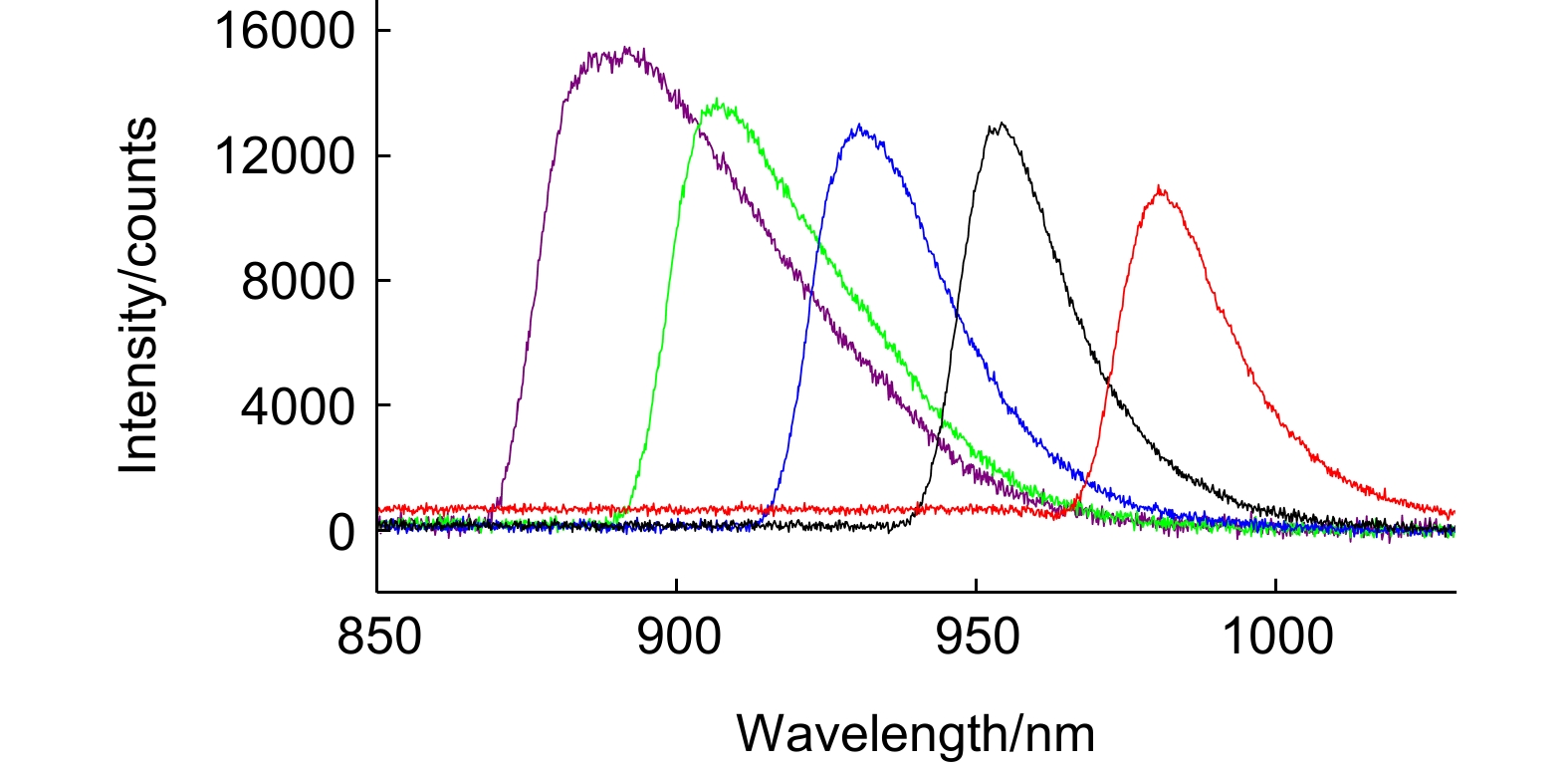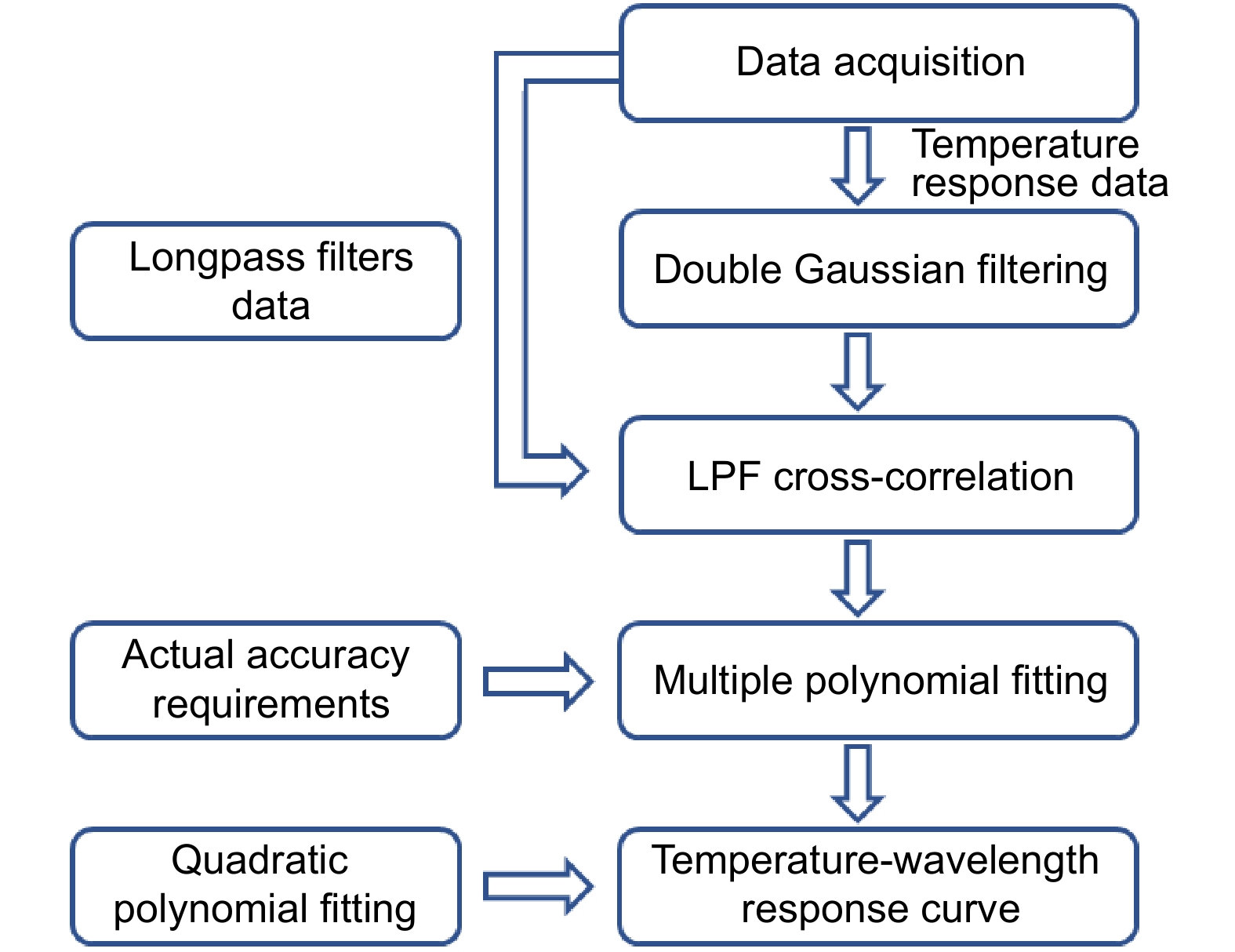Demodulation method for GaAs optical fiber temperature sensing based on reference filter and cross-correlation algorithm
-
摘要
本文提出了一种基于参考滤波器及互相关算法的新型砷化镓光纤温度解调方法。该方法利用二次高斯滤波方法实现数据平滑预处理,采用长波通滤波(LPF)波形作为参考波形的改进型互相关算法,实现砷化镓光纤温度的解调。基于获取的互相关运算相关系数结果,采用多次多项式拟合,进一步提高互相关算法解调精度。在−30 ℃至250 ℃的测温范围内,该方法的波长解调误差可达到±0.0016 nm,平均温度解调误差为±0.388 ℃。相较于现有的归一化光强解调法,采用LPF波形作为参考波形的互相关算法在抗噪性能上实现了2.64倍的提升,且较之于未使用LPF参考波形的互相关算法提升了2.08倍。
Abstract
This paper presents a new demodulation approach for optical fiber temperature sensors based on GaAs, leveraging reference filtering and a cross-correlation algorithm. It preprocesses the data through double Gaussian filtering for smoothing and implements an enhanced cross-correlation algorithm adopting a long-pass filter (LPF) waveform as the reference signal to demodulate the GaAs optical fiber temperature sensor. Using the correlated data from cross-correlation operations, it applies a multiple polynomial fitting strategy to further augment the precision of the cross-correlation algorithm’s demodulation. Across a temperature sensing range of −30 to 250 ℃, the wavelength demodulation error of this method can reach ±0.0016 nm, and the temperature demodulation accuracy is ±0.388 ℃. Relative to the prevailing normalized optical intensity demodulation method, the cross-correlation algorithm employing an LPF waveform as the reference demonstrates a 2.64-fold increase in noise immunity and a 2.08-fold improvement over cross-correlation algorithms without the LPF reference waveform.
-
Key words:
- GaAs /
- Gaussian filtering /
- cross-correlation algorithm
-
Overview
Overview: GaAs, as a unique semiconductor material, is widely used in the field of optical communication and the production of various sensors. The temperature characteristics of GaAs material play an important role, but the existing demodulation technologies for the temperature response characteristics of GaAs have problems such as low noise resistance, low precision, and low accuracy. Therefore, a high precision and noise immunity demodulation method for the temperature response of GaAs crystals is needed. This paper proposes a new demodulation approach for optical fiber temperature sensors based on GaAs, leveraging the reference filtering and a cross-correlation algorithm. The algorithm mainly consists of a double Gaussian filtering algorithm for filtering and smoothing the original collected waveform, a cross-correlation algorithm using a low-pass filter (LPF) waveform as the reference waveform, and a multi-quadratic polynomial fitting algorithm for improving the demodulation precision and accuracy. The double Gaussian filtering of this algorithm can reduce the impact of noise during data collection, enhancing the algorithm's noise resistance. Compared with cross-correlation algorithms without the LPF reference waveform, this algorithm uses the LPF waveform collected by the same experimental data acquisition system as the reference waveform, solving the problem of low noise resistance when using the collected waveform as the reference and the inability of virtual waveforms to reflect the error impact of unstable factors in the collection system, such as the light source and spectrometer. At the same time, the use of a multi-quadratic polynomial fitting method ensures the accuracy and reliability of the maximum cross-correlation coefficient acquisition. Compared with the existing GaAs temperature response demodulation technologies, the noise resistance of this algorithm can be improved by up to 2.64 times. Meanwhile, the wavelength demodulation error of this method can reach ±0.0016 nm, and the temperature demodulation accuracy is ±0.388 ℃ with a temperature sensing range of −30 to 250 ℃, meeting the high-precision demodulation requirements in various application scenarios.
-

-
表 1 三个通道下归一化光强法(NI)、传统互相关算法(TC)与LPF参考波形互相关算法(LPF-C)的RMSE指标参数和平均温度解调误差
Table 1. Parameters of the RMSE indicator of normalized intensity method (NI), traditional cross-correlation algorithm (TC), and LPF reference waveform cross-correlation algorithm (LPF-C) in three channels, and average temperature demodulation error (ATDE)
Channel CH-1 CH-2 CH-3 TDA / ℃ NI 0.226123 0.208136 0.306429 0.469 TC 0.162197 0.17823 0.241403 0.408 LPF-C 0.107920 0.100972 0.115995 0.388 表 2 不同解调方法的性能对比
Table 2. Performance comparison of different demodulation methods
Ref Year Demodulation method Temperature sensitivity Temperature
demodulation accuracyWavelength
demodulation accuracyResolution [22] 2018 Wavelength demodulation 30 pm/℃ (for test) ± 0.2 ℃ 3 pm — [23] 2018 Fast cross correlation demodulation
algorithm based on dichotomy0.0205 ℃/μm 0.15 ℃ — 0.001 ℃ 2019 Optical cross correlation 14.076 pixel/℃ — — 0.005 ℃ /0.6 nm [24] 2023 Deep belief networks (DBNs) with
ensemble learning— 0.3% F.S. TDE (temperature demodulation
error)=0.98 ℃This paper LPF-cross correlation 0.3 nm/℃ TDE=0.388 ℃ 1.6 pm — -
参考文献
[1] 李天夫, 巴德欣, 周登望, 等. 前向受激布里渊散射光纤传感研究进展[J]. 光电工程, 2022, 49(9): 220021. doi: 10.12086/oee.2022.220021
Li T F, Ba D X, Zhou D W, et al. Recent progress in optical fiber sensing based on forward stimulated Brillouin scattering[J]. Opto-Electron Eng, 2022, 49(9): 220021. doi: 10.12086/oee.2022.220021
[2] Leal-Junior A, Avellar L, Biazi V, et al. Multifunctional flexible optical waveguide sensor: On the bioinspiration for ultrasensitive sensors development[J]. Opto-Electron Adv, 2022, 5(10): 210098. doi: 10.29026/oea.2022.210098
[3] 周朕蕊, 邱宗甲, 李康, 等. 光纤法布里-珀罗传感器的解调方法研究综述[J]. 光电工程, 2022, 49(6): 210411. doi: 10.12086/oee.2022.210411
Zhou Z R, Qiu Z J, Li K, et al. Review on demodulation methods for optic fiber Fabry-Perot sensors[J]. Opto-Electron Eng, 2022, 49(6): 210411. doi: 10.12086/oee.2022.210411
[4] Zhu C, Gerald R E, Huang J. Progress toward sapphire optical fiber sensors for high-temperature applications[J]. IEEE Trans Instrum Meas, 2020, 69(11): 8639−8655. doi: 10.1109/TIM.2020.3024462
[5] Roriz P, Silva S, Frazão O, et al. Optical fiber temperature sensors and their biomedical applications[J]. Sensors, 2020, 20(7): 2113. doi: 10.3390/s20072113
[6] Zhou X, Gong P Q, Ai Y, et al. Miniature optical fiber DNA hybridization sensor with temperature compensation using a gold nanofilm-coated optical fiber[J]. IEEE Sens J, 2023, 23(7): 6931−6938. doi: 10.1109/JSEN.2023.3247599
[7] Liu H J, Zhou C M, Pang Y D, et al. High-resolution optical fiber temperature sensor based on draw tower grating array[J]. Sensors, 2022, 22(8): 2846. doi: 10.3390/s22082846
[8] Lei X Q, Dong X P, Lu C X, et al. Underwater pressure and temperature sensor based on a special dual-mode optical fiber[J]. IEEE Access, 2020, 8: 146463−146471. doi: 10.1109/ACCESS.2020.3015195
[9] Liu H H, Hu D J J, Sun Q Z, et al. Specialty optical fibers for advanced sensing applications[J]. Opto-Electron Sci, 2023, 2(2): 220025. doi: 10.29026/oes.2023.220025
[10] 肖文哲, 程静, 张大伟, 等. 用于光纤干涉传感器的高稳定PGC解调技术[J]. 光电工程, 2022, 49(3): 210368. doi: 10.12086/oee.2022.210368
Xiao W Z, Cheng J, Zhang D W, et al. High stability PGC demodulation technique for fiber-optic interferometric sensor[J]. Opto-Electron Eng, 2022, 49(3): 210368. doi: 10.12086/oee.2022.210368
[11] Chen Y C, Li J P, Guo X J, et al. On-chip high-sensitivity photonic temperature sensor based on a GaAs microresonator[J]. Opt Lett, 2020, 45(18): 5105−5108. doi: 10.1364/OL.399397
[12] Kolesnikova E A, Uglov V V, Drapezo A P, et al. Study of temperature coefficient of resistance of n-InSb films On i-GaAs (100) substrate and temperature sensors based on them[J]. High Temp Mater Processes, 2022, 26(3): 31−38. doi: 10.1615/HighTempMatProc.2022043589
[13] Yang T Y, Zhang X Y, Liu Z Y, et al. Thermal optical fiber sensor based on GaAs film for fluid velocity measurement[J]. IEEE Sens J, 2024, 24(8): 12358−12365. doi: 10.1109/JSEN.2024.3369053
[14] Calahorra Y, Husmann A, Bourdelain A, et al. Highly sensitive piezotronic pressure sensors based on undoped GaAs nanowire ensembles[J]. J Phys D Appl Phys, 2019, 52(29): 294002. doi: 10.1088/1361-6463/ab1386
[15] Zhang Z Q, Guo Y, Li F, et al. A sandwich-type thermoelectric microwave power sensor for GaAs MMIC-compatible applications[J]. IEEE Electron Device Lett, 2016, 37(12): 1639−1641. doi: 10.1109/LED.2016.2619380
[16] Zhang Z Q, Gu R Q, Jiang Y F, et al. A near-zero thermoelectric RF power sensor for high dynamic range applications[J]. J Microelectromech Syst, 2024, 33(1): 9−11. doi: 10.1109/JMEMS.2023.3330574
[17] Wu J W, Yuan T T, Liu J J, et al. Terahertz metamaterial sensor with ultra-high sensitivity and tunability based on photosensitive semiconductor GaAs[J]. IEEE Sens J, 2022, 22(16): 15961−15966. doi: 10.1109/JSEN.2022.3190414
[18] 胡昆, 傅惠南, 罗星星, 等. 多通道自校准砷化镓吸收式光纤温度监测系统[J]. 中国激光, 2015, 42(11): 1105001. doi: 10.3788/CJL201542.1105001
Hu K, Fu H N, Luo X X, et al. Multi-channels self-calibrating gallium arsenide absorption fiber optic temperature monitoring system[J]. Chin J Lasers, 2015, 42(11): 1105001. doi: 10.3788/CJL201542.1105001
[19] 胡昆, 董玉明, 傅惠南, 等. 砷化镓吸收式光纤温度传感技术的解调方法[J]. 光电工程, 2015, 42(10): 61−66. doi: 10.3969/j.issn.1003-501X.2015.10.011
Hu K, Dong Y M, Fu H N, et al. Demodulation method about gallium arsenide absorption fiber optic temperature sensing technology[J]. Opto-Electron Eng, 2015, 42(10): 61−66. doi: 10.3969/j.issn.1003-501X.2015.10.011
[20] Chen K, Wang Z L, Guo M, et al. Single-mode fiber-optic Fabry-Perot interferometry sensor based on optical cross-correlation demodulation[J]. Opt Eng, 2019, 58(2): 026106. doi: 10.1117/1.OE.58.2.026106
[21] Guo M, Chen K, Zhang G Y, et al. High-sensitivity fiber-optic low-frequency acoustic detector based on cross-correlation demodulation[J]. J Lightwave Technol, 2022, 40(13): 4481−4488. doi: 10.1109/JLT.2022.3164134
[22] Zhu W S, Jiang J F, Wang J, et al. Research on wavelength demodulation method based on optical fiber Fabry-Perot tunable filter[J]. Proc SPIE, 2018, 10821: 1082106. doi: 10.1117/12.2500618
[23] 孟华, 李海洋, 曹占启. 一种用于海洋温度快速测量的光纤法布里-珀罗温度传感器[J]. 中国激光, 2018, 45(12): 1210001. doi: 10.3788/CJL201845.1210001
Meng H, Li H Y, Cao Z Q. An optical fiber farby-perot temperature sensor for rapid ocean temperature measurement[J]. Chin J Lasers, 2018, 45(12): 1210001. doi: 10.3788/CJL201845.1210001
[24] Wang L X, Liu H J, Pan Z, et al. Temperature demodulation for optical fiber F-P sensor based on DBNs with ensemble learning[J]. Opt Laser Technol, 2023, 162: 109275. doi: 10.1016/j.optlastec.2023.109275
-
访问统计


 E-mail Alert
E-mail Alert RSS
RSS

 下载:
下载:











